Beef Glossary: A Glossary Of The Different Beef Types & Beef Cuts DiagramBeef Cut TypesPage 2: Types Of Beef Terms & Definitions C To E This is Page 2 of an 8-page article. Click on the red links below to visit other pages. This glossary is protected by copyright and cannot be reproduced in whole or part. You are welcome to link to it.
|
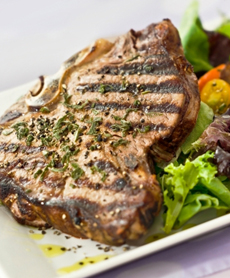 A favorite beef cut among connoisseurs: a dry-aged Porterhouse steak. Photo courtesy of NimanRanch.com. |
|
|
If you’re looking for the definition of a particular cut of beef, you’ve come to the right place. Here’s the lingo butchers and other industry professionals use as they cut beef. (If you’d like to suggest additional words, click here.) On this page of the glossary, you’ll find terms such as aged beef, beef bacon, beef cheeks, beef jerky, beef stew meat, Black Angus beef and an answer to the question, What is beef? When looking up beef cuts, it’s helpful to refer to the beef cut diagram, courtesy of the National Cattleman’s Beef Association. If you enjoy this Beef Glossary, we have a food glossary for almost every category of food—including a Lamb Glossary and a Pork Glossary. 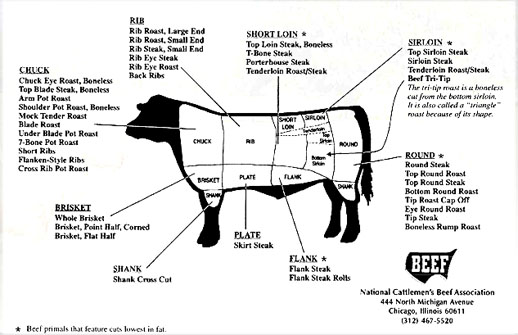
Download your own beef cuts chart (pdf).
|
||
| CALF FRIES Another term for fried bull testicles or prairie oysters. In particular, calf fries are taken from very young animals.
|
||
| CARPETBAG STEAK Not a cut of meat but a preparation, first popularized in Sydney, Australia around 1950. It consists of an end cut of rib-eye steak (known as scotch fillet steak in Australia), served standing up like an old-fashioned carpetbag (or a miniature mountain). Small cuts make pockets in the meat, into Sydney rock oysters are stuffed and secured with toothpicks. The whole may be wrapped in a strip of bacon, and it is often served with roasted new potatoes.
|
||
| CENTER CUT Generally refers to steaks cut from the heart of the rib-eye. A very flavorful, juicy, tender cut.
|
||
| CERTIFIED ANGUS BEEF® Certified Angus Beef is a trademarked brand that licenses the trademark to ranchers who are approved by the licensor. The brand promises the consumer consistently flavorful, juicy and tender cuts. Less than 8% of beef is Certified Angus Beef. It is the best-known brand; more than 50% of all beef approved through USDA brand certification (i.e., branded beef) is Certified Angus Beef. See also Angus cattle.
|
 Photo courtesy Certified Angus Beef. |
|
| CHATEAUBRIAND or TOURNEDOS or FILET DE BOEUF Chateaubriand is not a cut of meat but a recipe using the tenderloin. It was created by the personal chef, Montmireil, of Vicomte Fran&c cedil;ois-René de Chateaubriand (1768-1848). The Vicomte was a French author, considered to be the founder of Romanticism in French literature. He also was a soldier and statesman who served Napoleon as an ambassador, and King Louis XVIII as Secretary of State. According to Larousse Gastronomique, during the time of the Vicomte, the steak was cut from the chewy but tasty sirloin and served with a white wine and shallot sauce that included demi-glace, butter, tarragon and lemon juice. Montmireil instead chose the very tender (although less flavorful) tenderloin. The meat was cut from the thickest part of the tenderloin which provides just two portions (all of the tenderloin can be cut into filet mignon). It was grilled “larded,” with a strip of bacon or lard around it to keep it moist, and served medium rare (never well done) with a similar sauce (today béarnaise sauce is served) and château potatoes, which were cut into the shape of large olives, parboiled and cooked in butter.
|
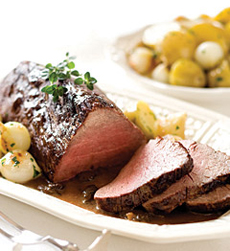 Chateaubriand from Montana Legend available at MackenzieLtd.com. |
|
| CHEESE STEAK or PHILLY CHEESE STEAK A fast-food sandwich invented by a Philadelphia hot-dog stand owner in 1930, the cheese steak consists of thin, grilled slices of steak topped with melted cheese on a hoagie roll. Today Cheez-Whiz, is the topping of choice because it melts the quickest, although white American cheese and provolone are considered authentic (Cheez-Whiz was not invented until 1952).
|
 A cheese steak. Photo courtesy Dietz & Watson. |
|
| CHICAGO-STYLE STEAK A preparation of steak, cooked to the desired level and then quickly charred. The diner orders it by asking for the style followed by the level of doneness, e.g. “Chicago-style rare.” In some areas it is also referred to as Pittsburgh-style steak.
|
||
| CHICKEN-FRIED STEAK or COUNTRY FRIED STEAK A Southern specialty, chicken-fried steak is the American version of Wiener Schnitzel*, but instead of a tenderized veal cutlet, a tenderized cut of beef (a cube steak) is coated with seasoned flour and pan fried. It gets its name from its resemblance to fried chicken. In a redundant and ironic twist, the dish called “chicken fried chicken” pounds, breads, and pan fries a chicken cutlet. This preparation is distinctively different from regular fried chicken, which breads bone-in chicken parts and deep-fries them. *Wiener Schnitzel means Viennese scallops, referring to the scallops of veal, another word for thin cutlet. Wiener Schnitzel is the national dish of Austria.
|
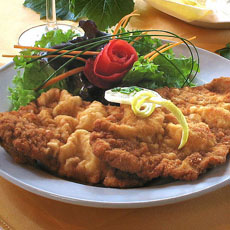 Wiener Schnitzel. Photo by Kobako | Wikimedia. |
|
| CHIPPED BEEF or CHIP BEEF Chipped beef, erroneously referred to as chip beef, is dried smoked beef similar to Italian bresaola, which is more flavorful because it is aged; the “chips” refer to the slivers in which it is packaged. Creamed chipped beef on toast was standard diner fare in the first half of the century. The recipe sauce rehydrates the dried beef and mixes them in a white sauce flavored with parsley and pepper. toasted bread. Hormel recommends flavoring the dish with Worcestershire sauce and dried parsley WHY SPEND MORE? HERE ARE THE BEST VALUE CUTS OF STEAK
|
||
| CHUCK or SHOULDER CUTS There are more than a half dozen cuts from the shoulder (the area between the neck and the shoulder blade) including arm steak, blade steak, chuck steak, chuck eye steak, mock tender steak, seven bone steak, shoulder steak and under bone steak. All of them have excellent flavor, but they are usually tougher than cuts from the loin, sirloin or rib sections, and are thus less expensive. These multi-muscled steaks are best cooked by braising. Ground chuck has the best percentage of meat to fat for hamburger. The blade steak is one of the most tender of all steaks after a line of tough connective tissue down the middle is removed. It has a great flavor and is inexpensive compared to steaks from the loin, sirloin and rib. The rest of the steaks from the chuck all have good flavor and texture, but they can be quite fibrous. They can be bone in or boneless, cut thick or thin, and can be broiled or roasted successfully, especially if marinated or tenderized. However, the best way to cook chuck steaks is to braise them by searing on both sides, adding a small amount of liquid (seasoned broth or wine), covering tightly and simmer until tender.
|
||
| CHUCK ROAST A full-flavored roast, rectangular in shape, popular for a classic pot roast. Best for slow-cooking in the crock pot, braising or in stews. It also can be stir-fried.
|
||
| CHUCK STEAK An extremely well marbled, full-bodied and robust steak. The typical chuck steak is a rectangular cut, cut about one-inch thick, with parts of the shoulder bones, and is known as a “7-bone steak.” This is a reference to the shape of the bone, which resembles the numeral 7. From a good producer, this can be a very satisfying cut.
|
 Chuck roast. Photo courtesy Cybercucina.com. |
|
| CHUCK TENDER STEAK Don"™t trust the name; this cut is not tender! It is a flavorful cut, however, from the shoulder clod. It needs to be marinated or braised before broiling, grilling or pan-searing Alternate names include chuck clod tender, , chuck fillet steak, chuck mock tender steak, fish steak and Scotch tender.
|
||
| CLOSED HERD A herd of farm animals that is 100% born and raised on the farm. No animals are ever brought in from the outside. This ensures the health of the herd; outside animals can bring in infections, viruses and diseases including “mad cow” and hoof and mouth disease. Maintaining a closed herd is especially important to an organic herd, since animals cannot be treated with antibiotics, and an animal requiring such care must be removed from the herd.
|
||
| CLUB STEAK Although really a strip steak, the term “club steak” refers specifically to the last steak from the rib end of the loin. It has the flavor and texture of a strip steak. It is cut from the short loin, next to the rib end; it is smaller than a Porterhouse steak but with the same large “eye” section. When cut properly, it is a tender steak.
|
||
| CONNECTIVE TISSUE The tissue between and within muscles that helps bind muscles together, and attaches muscle to bone for support.
|
||
| COWBOY STEAK or CÔTE DE BOEUF A cowboy steak, called côte de bœuf in French, is a bone-in rib eye steak with a frenched rib bone. This “raw bone” feature and the fact that this cut is generally around two pounds of meat, makes it big enough for the hungriest cowboy—or enable two people to share. It’s sometimes called a cowboy chop because it looks like an enormous chop.
|
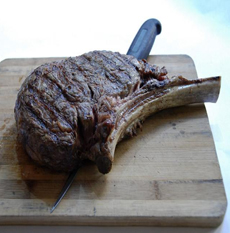 Cowboy steak. Photo courtesy OnlyWithTilia.com. |
|
| CORNED BEEF Corning refers to curing or pickling the meat in a seasoned brine. The word refers to the “corns” or grains of kosher (or other coarse) salt that is mixed with water to make the brine. Typically, brisket is used to make corned beef. The dish has many regional variations and seasonings. Historical note: Irish immigrants adapted corned beef from their Jewish neighbors on New York’s Lower East Side as a cheaper alternative to Irish bacon, precipitating the now-traditional Irish-American dish, corned beef and cabbage. Smoking a corned beef, and adding extra spices, produces pastrami.
|
 Corned beef with carrots and cabbage. Photo courtesy Guinness. |
|
| CORN FED or GRAIN FED Cattle that eat a diet of corn. In addition to being unhealthy for the animal, it creates a fattier meat than the leaner, grass-fed beef.
|
||
| CÔTE DE BOEUF See cowboy steak, above.
|
||
| COUNTRY FRIED STEAK See chicken fried steak. |
||
| CUBE STEAK or MINUTE STEAK A flavorful cut of beef, generally from the top or bottom round. It is tenderized (cubed) by pounding it with a mallet or running it through a tenderizing machine—cubing is a process, not a cut. Either technique makes a cube-shaped pattern in the meat. Cube steak would be too tough to eat without being tenderized. It is the cut generally used for Salisbury steak and chicken fried steak, where it is coated and pan fried, almost as if it were a piece of fried chicken. It is also a popular cut cut for steak sandwiches and cheese steaks. See also minute steak. While mankind has used different grinding, pounding and scoring techniques to tenderize tough meat, cube/cubed steak seems to have appeared in the 1920s. There is a reference to the Cube Steak Machine Company of Boston, which patented a cubing device in 1926. The company advertised in Good Housekeeping magazine: “Cubing improves the flavor in any cut of meat…triples the cooking surface and reduced time required for cooking.” (Source: FoodTimeline.org.)
|
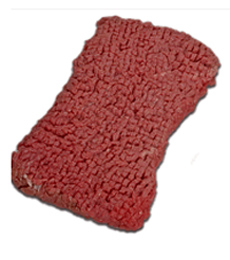 Cube steak available from WhiteOakPastures.com. |
|
| CULOTTE STEAK or TOP SIRLOIN CAP STEAK A small, boneless steak, the sirloin cap steak is a flat, triangular-shaped muscle that lies immediately over the top sirloin. Culotte steaks are flavorful but lean, with less marbling than a New York strip steak or a Porterhouse. Thus, they are a bit tougher than other sirloin steaks, requiring marinating prior to cooking. It can be cooked whole, cut into cubes for kabobs and stews, or cut into strips for stir-fries or steak sandwiches.
|
||
| DELMONICO STEAK or SPENCER STEAK See rib-eye steak.
|
||
| DRY-AGED Dry-aged beef is fresh beef that has been hung to dry (or set on wooden racks) in an aging room for several weeks under controlled temperatures, humidity and air flow to reduce spoilage and enhance flavor and tenderness. It is compared to aged wine: The flavors have deepened and mellowed. Only the more expensive cuts of meat can be dry-aged, as the process requires meat with a large, evenly distributed fat content. In the process, the meat may lose up to 25% of its weight in liquid, which is part of concentrating the flavor. Dry aging also makes the meat a darker color, with an aged aroma. Some connoisseurs prefer dry-aged beef because this concentration results in a more intensely-flavored (if smaller) piece of meat. In addition to the loss of liquid, changes occur the meat itself. Natural enzymes in the meat break down the fibers, enhancing the taste with a delicious nutty flavor and tender texture. During dry-aging, steaks are kept on racks in a special room with temperature, humidity and air circulation carefully controlled at near-freezing temperatures. That’s why dry-aged beef is more rare and more costly than fresh-packed beef, and is generally available only at specialty butcher shops and fine restaurants. See also wet aged beef, also known as vacuum aged beef.
|
 Dry-aged strip steak. Photo courtesy NimanRanch.com. | |
| DRY-HEAT COOKING
The most tender cuts—rib steak, strip steak, sirloin, chuck or round steaks—can be cooked quickly by dry heat—broiled, grilled, pan-fried or roasted.
|
||
| ENTRECÔTE The French word for what Americans call the rib eye steak. Pronounced on-truh-COAT, the word means “between the ribs”—specifically the ninth through 11th ribs. A lean, tender cut of meat, the entrecôte is is best grilled or broiled, served rare or medium rare.
|
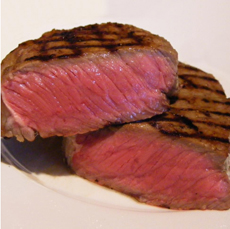 The entrecôte, or rib eye steak. Photo courtesy OnlyWithTilia.com.
|
|
| EYE OF ROUND ROAST The leanest of all roasts and the most tender of roasts from the round, you can see from the photo at the right that there is virtually no exterior fat. Just season and roast this cut for 20 minutes per pound at 300°F. It also does well cooked in warm moist heat such as a crock pot. Continue To Next Page, Terms With F, G & H Go To Glossary Alphabet Index, Above
|
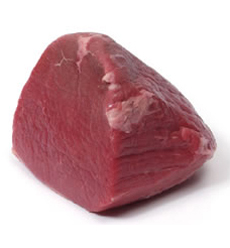 Eye of round roast. Photo courtesy GlacierBeef.com. |
|
|
Lifestyle Direct, Inc. Some definitions were provided by the Cattlemen’s Beef Board and are © Copyright 2005 Cattlemen’s Beef Board. All rights reserved. Images are the copyright of their respective owners.
|
||
Last Updated Apr 2018
© Copyright 2005-2025 Lifestyle Direct, Inc. All rights reserved. All images are copyrighted to their respective owners.